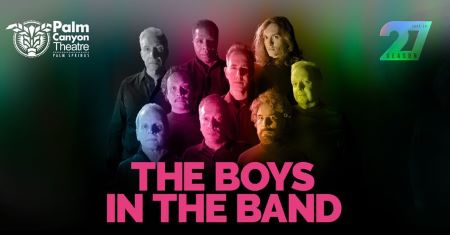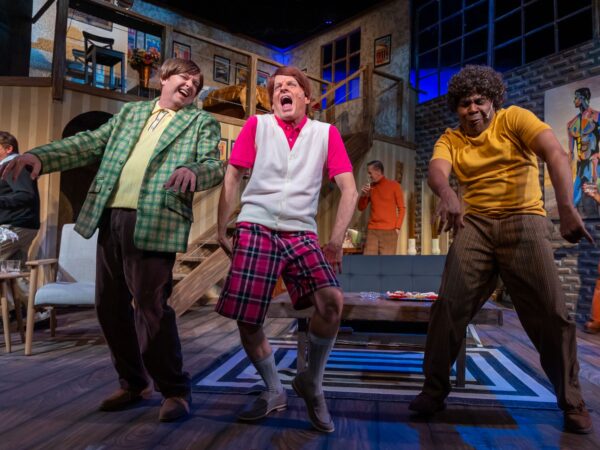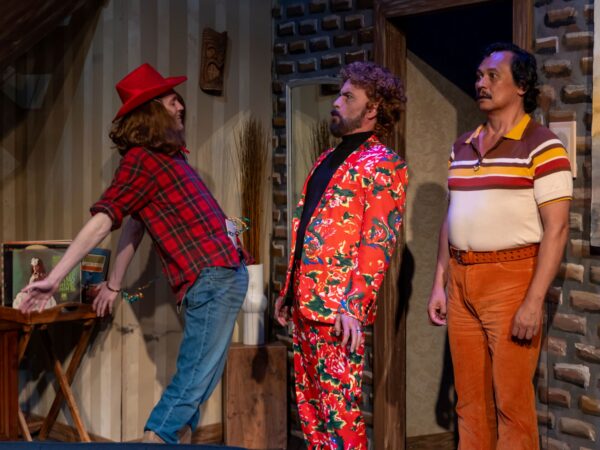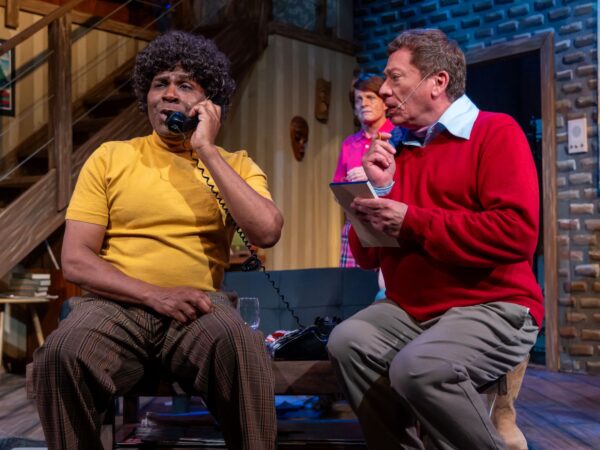Still impactful, The Boys in the Band, now playing at Palm Canyon Theater until April 21, is largely based on playwright Mart Crowley‘s own life in 1960s’ Manhattan. The 1968 play was a sensation Off-Broadway, won Tony for Best Revival of a Play in 2019 starring an all-gay cast, and was filmed twice.
When the show starts, we meet Michael (Kam Sisco), a 30-year-old, insecure shopaholic who is readying his apartment for his dear friend Harold’s birthday party. Pseudo-boyfriend Donald (Ron Coronado), visiting for the party, quips about life while he showers (there is a moment of backside nudity from Coronado) and how his struggle with anxiety is affecting him to the point that his doctor is “sick” from hearing from him. Larry (Adam Hieter) arrives with husband and high school math teacher Hank (Luke Rainey). Larry, a commercial artist who is not a fan of monogamy, had a hook up with Donald in the past, which makes for an interesting conversation during the party when Hank — who ended a straight marriage for Larry — finds out.
Bernard (Dwayne Arvinger), a nicely dressed African-American bookseller, arrives with bestie Emory (Larry Martin), a swishy, funny queen who adores gay culture, but often tosses racial remarks to Bernard (“So says the African Queen!”). Arriving at the party without an invitation is Michael’s old college chum, Alan (Brent Anderson), who is in a heterosexual marriage and whom Michael asserts is in the closet. Alan had called Michael at the top of the show with anxiety, but once he shows up he never discloses to Michael the reason was for the visit.
After a fight with Emory, Alan heads to the bathroom. That’s when Emory’s present to Harold, the beautiful young escort Cowboy (Sabastian Reda), shows up. Finally, the birthday boy Harold (Rob Kreisinger Denk), a wry self-effacing “Jew Fairy,” arrives late — as usual. The party is underway with dancing, confrontation, a lot of drinking, pot-smoking and confessionals. In the second act, Michael leads a cruel parlor game of “Truth” that has partygoers making phone calls to the ones they truly loved.
The boys are all dealing with being gay or closeted in a repressive world, which leads to empowerment in some, shame in others. At Palm Canyon Theater, where Boys in the Band opened last night as part of PCT’s 27th season, the majority of actors have outgrown their prescribed character ages; they’re supposed to be in their low-20s to low-30s. This is an ongoing problem in the Coachella Valley when actors do not fit their character descriptions, which doesn’t make sense. There is plenty of eager talent locally available that does fit the criteria. The only character who seemed to be cast in the correct age range was Cowboy. While Reda isn’t as musclebound as the script states, he did portray his character’s intellectual abilities quite well, if not a little dry. As Emory, Mr. Martin came off like an old man trying to be a young schoolboy.
It’s not, I suppose, that the “Boys” in this band have to cast as young. Yet director Eric Stein-Steel keeps this in 1968, which is just before Judy Garland’s death and Stonewall when young activists with nothing to lose gave up on older gays who wanted to be politically safe. But it’s even more of an oversight when the acting is a mixed bag overall. While Anderson was a little shaky on lines at first, he gave a few shining moments as Alan, especially the scene with a terrifically intense build up with Emory, who asserts that Alan is gay. As Emory, Martin was late picking up cues, which disconnected the dialogue and sounded awkward, as Emory is supposed to be quick, loud and unfiltered. With so much dialogue, pacing here is crucial.
The over-the-top acting Sisco delivered as Michael was like watching a soap opera. There was so much embellishment that listening to his many monologues became fatiguing. His acting felt exactly like acting. The rest of the cast gave down-to-Earth performances that created empathy for their characters. As my favorite character Harold, Mr. Kreisinger Denk offers a layer-rich performance; from witty remarks to a confrontation with Michael, he was spot on. Any time Kreisinger Denk spoke, the scene lifted up into a realm of pure enjoyment. This is a performance you will not want to miss. Rainey gave a stellar performance as Hank, the doting husband who was struggling with trying to keep his husband happy. Hieter had some great moments too as Larry but seemed to be a little deadpan at first.
Some of the best performances came during the telephone party game scene. When Martin delivered Emory’s monologue about a guy he loves but can’t have, his pain was acute, causing audible sniffles from the audience. Arvinger was wonderful to watch as Bernard — the fun he brought to his character, and the pain and regret he feels after making his telephone call to the person who he loved the most was heart-wrenching. And Hieter and Rainey were incredibly touching in this scene — I even got misty-eyed watching them.
And since these “boys” are mostly older men, wigs were used, but often to great detriment. Harold is described to Cowboy as having black tight curly hair when the wig that was given to him was light brown. Hieter fits Larry’s description of being handsome, but his good looks were sabotaged by a wig that made him look like a blonde Lord Farquaad from Shrek — Sisco’s wig just looked horrible. He did have an interesting pink-and-white costume, courtesy of designer Derik Shopinski, who, with costume assistant Virginia Sulick, did their research and tracked down great costumes perfect for the era (I’m just speculating, but Palm Springs’ well-known thrift stores may have helped). There were even some costumes that I wanted for myself. One thing confused: being basically an man uncomfortable with himself, Michael changes sweaters at the start, but then he would just pop up with a differently colored sweater every so often, which the dialogue doesn’t call for. It’s an interesting directorial choice, elucidating Michael’s obsessions, but it came off as confusing more than anything else.
The pre-show music you hear really did set the mood of being in the late ’60s. Walking into the theater, you are met with a surprisingly beautiful set of a two-story apartment, designed by Stein-Steele and constructed by Jackson Enzler and Joyanne Tracy. It makes you forget that PCT’s stage is actually quite small. The chic artwork hanging on the walls is gorgeous, three of the paintings are by Dr. Bill Layne and will be raffled off at the end of the run.
Except for an area downstage right that was part of the apartment but not lit, and a small section of missing light that put actors in partial darkness, Co-Artistic Director J.W. Layne ‘s design was damn near perfect. Light board operator Danny Hargreaves did an amazing job hitting the light cues.
This theatre has always been plagued with sound problems. The Boys in the Band, designed by Michael Hadley, did not have many issues. However, because microphones were practically inside most of the actors’ mouths, it was bothersome to hear them breathe heavily and, when they shouted, popping speakers. Sisco’s bad microphone placement was the worst offender, as we heard every single time he was out of breath, especially after going up or down the stairs. Actor’s microphones were turned on and off willy-nilly so lines were dropped. Was there a sound board operator? The program doesn’t mention an operator, but there definitely needs to be someone who can be dedicated to only sound such that these problems can be abolished.
photos by Sonny Von Cleveland
The Boys in the Band
Palm Canyon Theater, 538 North Palm Canyon Drive in Palm Springs
Thurs at 7; Fri and Sat at 8; Sun at 2
ends on April 21, 2024
for tickets ($17-$32), call 760.323.5123 visit PCT








{ 2 comments… read them below or add one }
I loved this show! It was fun and well thought out. It did not leave me wanting to slit my wrist like the other productions I’ve seen. It was the favorite of all the live versions of Boys I’ve seen! I applaud the use of older actors, since age is not actually relevant to the script in any way. Age appropriate casting leads to youngsters that lack maturity and understanding for the roles. The understanding of “that time†and “ that kind of gay†is important to telling this tale. From the tone, I can only wonder if Mr. Franco has, perhaps, a long standing vendetta or grudge with the theatre.
I attend theater regularly and know many patrons of the arts. Of the 20+ folks with whom I’ve spoken or from whom I’ve read a social media post, no one else, but Mr. Franco has seemed so disapproving. And in fact, most of the other comments encouraged others to attend. However, everyone is certainly entitled to their opinion!
I recently came across a post which sums up my feeling about this review…
“I’m shocked at some of the venom people think they have a right to spew, critics included. Productive criticism is one thing but people being deliberately mean with an apparent willingness to hurt people’s hearts and destroy people’s work makes me so sad.
And I just think the worst thing that could happen is that people stop making art. It’s so important to make art and reviews are like, f**k, who cares?â€
I really appreciate this review. This script is my next directing project with my theatre company (Silent House Theatre Company in Waco, TX), and part of my preliminary research is looking at reviews to see what critics thought worked — and did not work — with other versions of the show. I am a young director (24) with a age-appropriate cast, so I’m hoping to remedy some of the issues you have stated here. I was particularly struck with some of your observations about pacing and why the political context makes the age of the characters relevant! It left me wondering: which of these characters would be at the Stonewall riots? Which would want to go… but could not? Which would be completely opposed…? Thank you for this.